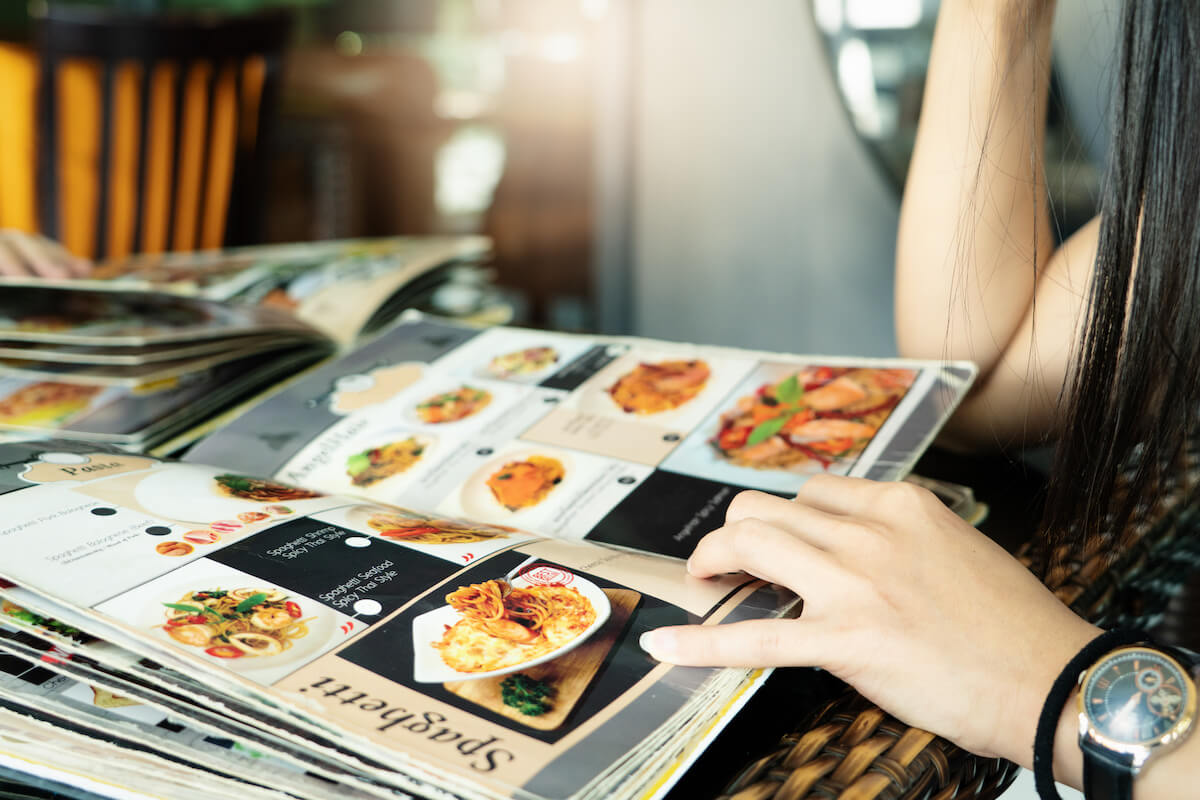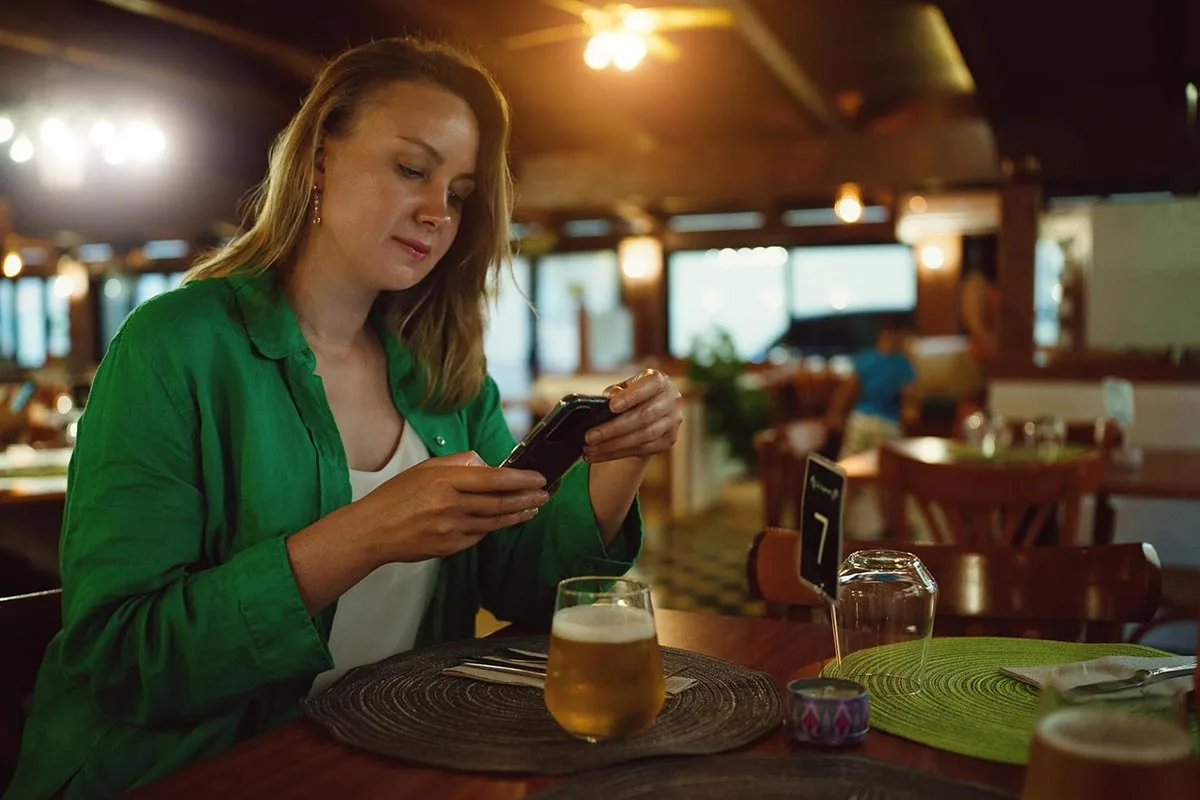Learn the 5 steps of menu engineering for better profits
Skip the article and turn takeaways into action by scheduling a call with our team.
So, you’ve done your marketing, and customers are walking in the door. Great! The next step is for them to sit down and order something. That means they’re going to look at your restaurant menu, and your menu engineering needs to direct them to the items you’d like them to order.
Menu engineering is a strategic approach to designing both print and digital menus that helps a restaurant make money while steering customers to smart choices. Menu engineering blends data analytics, psychology, and visual design to create menus that work smarter, not harder.
Your menu is the most valuable bit of information customers have about you. Putting some forethought and tweaks into your menu design provides an excellent return on investment and helps drive sales of high-profit items.
Let’s explore the menu engineering framework more in-depth and review the five steps that can guide your food offerings, pricing, and menu redesign.
What is menu engineering?

Menu engineering is the art and science of designing a menu to influence customer choices, maximize profits, and streamline operations. While previously it focused on print menus, it now encompasses both print and digital menu formats, like QR code menus and interactive displays on tablets or kiosks.
Analyzing data from point-of-sale (POS) systems or other restaurant software gives restaurateurs an indication of how to strategically place, price, and describe dishes to drive sales.
At its core, menu engineering uses a profit vs. popularity framework to categorize dishes. It looks like this:
- Stars: High-profit, high-popularity items
- Plowhorses: Low-profit, high-popularity items
- Puzzles: High-profit, low-popularity items
- Dogs: Low-profit, low-popularity items
This framework, combined with real-time data and modern design principles, can help you make informed decisions about what menu items to promote, reprice, or remove. We’ll cover more on these—and how to handle them—later on.
5 steps to master menu engineering
Below is a how-to guide featuring five steps to get your menu working for you. As this is a step-by-step guide, we strongly encourage readers to start with step one. Time spent on the data-gathering and analysis sections will make everything else fall into place comfortably.
1. Gather the right data
Data is the backbone of effective menu engineering—smart, data-driven decisions beat guesswork any day. Modern restaurants lean into integrated systems to glean actionable insights while avoiding mind-numbing manual number-crunching. Here are some ways to get started:
- POS and management systems: Make the most of your POS system or front-of-house (FOH) management system. Many popular POS systems gather lots of data and integrate with Yelp Guest Manager, which can store and parse valuable customer data.
- Food cost percentage: Calculate the food cost percentage for each dish. Aim for an average food cost of 25-35%, with some prestige items like a signature steak going higher, or high-profit items like appetizers being lower.
- Profit margins: Aim for ideal profit margin benchmarks. Shoot for a gross profit of 65-75% for each dish. Consider axing items that go below 60%, and heavily promote items above 80%.
- Menu item costs: Measure each menu item’s costs. Your cost of ingredients includes garnish, spices, and everything down to the sesame seeds.
- Competitors’ prices: Study your competitors’ menus thoroughly. Ensure you know what “normal” menu pricing is in your area.
- Portion sizes: Pay close attention to portion size. Standardized portion sizes are a solid way to practice cost control. If a dish can be profitable if it’s slightly smaller, tweak its portion to optimize profit margins.
- Yelp reviews: Dive into customer feedback on specific menu items as well as the customer experience regarding pricing, quality, and perceived value.
Update your data often—perhaps quarterly—to reflect changes in food cost, integrate new dishes into your system, and update menu prices as necessary.
2. Classify menu items

Once you’ve gathered your data, separate your dishes into a four-quadrant menu engineering matrix with profitability on the x-axis and menu item popularity on the y-axis. Separate the dishes into these categories:
- Stars: These are your cash cows, like a signature burger with a gross profit of 75% that sells like crazy. Stars have the highest profit contribution margin, i.e., they make up a lot of your bottom line. Promote these most profitable items prominently and consider bundling them with sides or drinks to further increase sales.
- Plowhorses: These are popular but low-margin items, like a discounted happy hour appetizer. Keep these to attract customers but nudge them toward higher-margin add-ons or pairings.
- Puzzles: These are high-profit but less popular items, like a specialty dessert or a unique chicken entree. These dishes have a low profit contribution margin, so experiment with better menu placement, descriptions, or more staff recommendations.
- Dogs: Low-profit, low-popularity items, like a niche dish with limited demand. Consider removing these or reframing them to minimize inventory food waste.
Use POS dashboards to track these categories over time. For example, a puzzle might become a star with a tweak in presentation or pricing, while a dog might need to be 86’d permanently if it consistently underperforms.
3. Follow menu design principles

A well-designed menu guides customers effortlessly to your high-margin items. Whether it’s a printed menu, a QR-code-accessed menu, or a digital display, keep these principles in mind and adjust your design as needed:
- Visual hierarchy and eye tracking: The Golden Triangle is a cornerstone of menu design. Customers’ eyes naturally go to the center, then top right, and then top left of a menu. Place stars in the top right, plowhorses in the top left, and puzzles in the center to draw attention. For digital menus, make sure the first screen or scroll features your stars.
- Menu length: Keep menus short—around 10-15 main dishes maximum for print, potentially more for digital menus with filters (e.g., vegan, gluten-free, etc.).
- Readability: Use clear fonts, like sans serif, for digital readability. Avoid visual clutter—white space draws attention to high-priority items.
- Print vs. QR code and digital displays: Print menus are still popular for their tactile appeal and ease of use, especially in upscale settings. QR-code menus, however, are popular in quick-service and casual dining restaurants. Digital displays are most common at quick-service and fast-casual restaurants and can feature visual flair to attract eyeballs and drive sales.
- Digital updates: Digital menus can be quickly updated to reflect pricing changes or promote specials.
Make sure your digital menus are mobile-optimized with fast load times, since most customers will be seeing them on their phones. For print, ensure your menus are printed on high-quality materials that match your restaurant brand identity. For example, upscale restaurants usually go with sleek and understated aesthetics, while casual restaurants have more of a vibrant and bold look.
4. Make actionable adjustments

To increase profitability, combine pricing, menu layout, psychology, and language strategies. Consider:
- Price anchoring: Use anchor pricing by placing a high-priced prestige item, like a $50 steak, next to mid-range stars, like a $20 burger, to make the latter seem like a good value.
- Prestige pricing: Sometimes, customers will purchase an item because it is the most expensive. Consider adjusting your highest prices slightly higher.
- Bundling: Create bundles (a fancy word for combos) like an entree, side, and drink to increase the average check size. A $15 burger can be paired with a $5 side and $3 soda for $20, boosting perceived value while keeping a high profit margin. You can follow a similar strategy with prix fixe menus for special days or events.
- Language and descriptions: Develop vivid, sensory-rich menu descriptions for stars and puzzles. Instead of “Ribeye steak,” try “Pan-seared aged Angus ribeye with house herb butter.” Use descriptions and storytelling for ethnic dishes diners may be unfamiliar with. Don’t be afraid to use humor—people like the human side of a restaurant.
- Color: Use green text for fresh, healthy items like salads; red for bold, hearty dishes like burgers; or yellow for reliable standards to trigger emotional responses. This is called the ketchup and mustard theory, and it’s based in deep psychology.
- Images: Adding images to a menu can be valuable for many restaurants, with the notable exception of fine dining. Even if you prefer to keep images off your physical menu to maintain a certain aesthetic, be sure to include them on online ordering or delivery app menus. Images can enhance your menu item descriptions by making them visually appealing. They can also give diners a better sense of what to expect, especially when they’re ordering from home where they can’t ask questions about a menu item.
- Underperformers: Drop your menu items in the “dogs” category unless they serve a strategic purpose, like niche vegan items. For puzzles, test new menu placements or descriptions before removing them. Consider framing them as limited-time specials to boost sales.
- Whole numbers and dollar signs: Keeping numbers whole (i.e., $18 instead of $17.99) makes a restaurant look honest and no-nonsense. Dollar signs are largely superfluous—customers know what you mean when you put a number next to the dish. Furthermore, a famous Cornell study indicated that removing dollar signs increases the average customer spend. This is possibly because it reduces the perceived cost of a dish and encourages a customer to focus more on the experience.
Test these changes and follow the results via your POS data. A/B testing digital menus on different days can show what works with customers and how effective menu placement can be.
5. Use tools for menu engineering

Modern menu engineering relies on technology to streamline analysis and design. Check out the following:
- Menu design software: Tools like Canva or Adobe Express offer templates for both print and digital menus, which helps keep your brand consistent. Menuzen is a free online menu maker that can make life easy, as it integrates with POS systems for real-time updates.
- Data dashboards: Tools like Yelp Guest Manager provide detailed analytics on menu item performance, customer preferences, and sales trends. For example, Yelp Guest Manager can show you what sells best on a Tuesday to your regulars—helping you figure out what dishes drive repeat visits.
- AI tools: AI, of course, is making its way into menu design. You can use AI to help you create detailed and enticing menu descriptions.
These tools can make a powerhouse menu designer out of even the most visually clueless restaurant owner, saving lots of time and money.
FAQs about menu engineering
Still have questions? Below are answers to some frequent inquiries about menu engineering.
How often should I update my menu pricing or layout?
Plan to review your menu pricing quarterly, as that gives enough time to observe the changes in ingredient costs or inflation. Update your menu layouts annually, or seasonally if you opt for a seasonal menu, if your data shows you need to. Digital menus allow for more frequent tweaks, so you may choose to test small changes monthly on a digital menu.
What are the easiest ways to identify underperforming menu items?
The easiest way to identify underperforming menu items is to use your POS or FOH management software to track sales data and your total costs. Items with low sales—those in the bottom 10%—and items with margins below 60% are likely dogs or puzzles needing attention. Cross-reference the data with customer feedback via Yelp reviews to check for any quality issues.
Can I apply menu engineering to a rotating or seasonal menu?
Yes, you can apply menu engineering to a rotating or seasonal menu Use the same profit vs. popularity framework, but tap into digital menus for more flexibility. Use your historical data to predict which seasonal items will perform best, or see what AI says. QR menus will make this easy—no trips to the print shop.
Get smart and savvy with menu engineering
Menu engineering is a powerful tool for boosting profits. Perform a menu analysis based on reliable metrics, tap into customer psychology and style elements in your menu redesign, and place items with vivid descriptions and visual cues. Optimize your pricing with anchors and bundles to increase the average check size.
Solid decision-making relies on data, and the best way to gather that data is with top-notch tech. Enter Yelp Guest Manager, the platform that handles your FOH systems. From POS syncing to reservation and waitlist management and everything in between, restaurant operators and their staff will have all the tools they need to make smart choices and keep customers coming back for more.
We’d love to show you what it’s all about. Give us a shout for a free demo, and we’ll show you the ropes—and how you can make the most of your data to improve your menu’s performance.